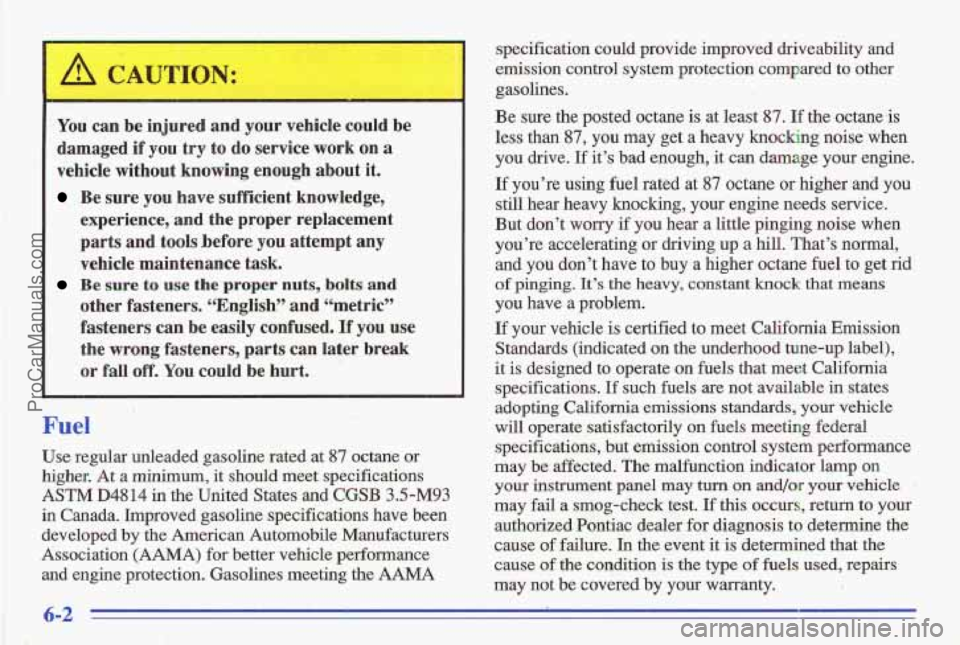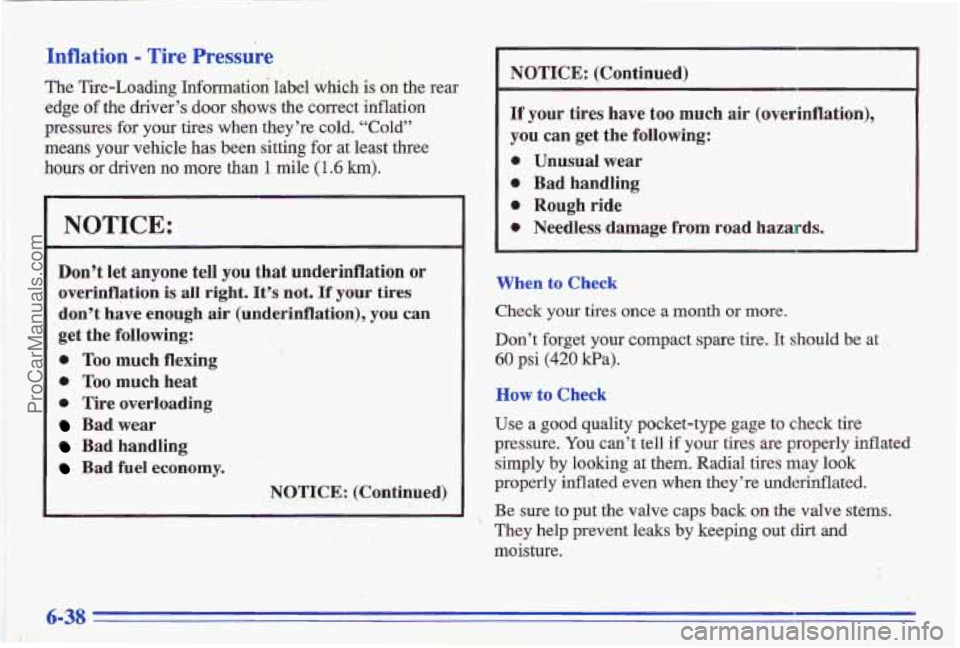Page 224 of 356

A CAUTION:
You can be injured and your vehicle could be
damaged if you try to do service work on a
vehicle without knowing enough about it.
Be sure you have sufficient knowledge,
experience, and the proper replacement
parts and tools before you attempt any
vehicle maintenance task.
Be sure to use the proper nuts, bolts and
other fasteners. “English” and “metric”
fasteners can be easily confused. If
you use
the wrong fasteners, parts can later break
or fall off. You could be hurt.
,, ~
Fuel
Use regular unleaded gasoline rated at 87 octane or
higher.
At a minimum, it should meet specifications
ASTM D4814 in the United States and CGSB 3.5-M93
in Canada. Improved gasoline specifications have been
developed by the American Automobile Manufacturers
Association
(AAMA) for better vehicle performance
and engine protection. Gasolines meeting the AAMA specification could provide improved driveability and
emission control system protection compared to other
gasolines.
Be ,sure the posted octane
is at least 87. If the octane-is
less
than 87, you may get a heavy knocking noise when
you drive. If it’s bad enough, it can damage your engine.
If you’re using fuel rated at 87 octane or higher and you
still hear heavy knocking, your’engine needs service.
But don’t worry if you hear a little pinging noise when
you’re accelerating
or driving up a hill. That’s normal,
and you don’t have to buy a higher octane fuel to get rid
of pinging. It’s the heavy, constant knock that means
you have a problem.
If your vehicle is certified to meet California Emission
Standards (indicated on
the underhood tune-up label),
it is designed to operate
on fuels that meet California
specifications. If such fuels
are not available in states
adopting California
emissions standards, your vehicle
will operate satisfactorily
on fuels meeting federal
specifications, but emission control system performance
may be affected. The malfunction indicator lamp
on
you instrument panel may turn on and/or your vehicle
may fail a smog-check test.
If this occurs, return to your
authorized Pontiac dealer for diagnosis to determine the
cause of failure.
In the event it is determined that the
cause
sf the condition is the type of fuels used, repairs
may not be covered
by your warranty.
ProCarManuals.com
Page 228 of 356
NOTICE:
If you need a new cap, b'e sure to get the right
type.
Your dealer can get one for you. If you get
the wrong type, it may not fit or have proper
venting, and your fuel tank and emissions system
might be
damaged.
Things that burn can get on hot engine parts and
start
a fire. These include liquids like gasoline,
oil, coolant, brake fluid, windshield washer and
other fluids, and plastic
or rubber. You or others
could b'e burned. Be
careful not to drop or spill
things
that will burn onto a hot engine.
Checking "'lings Under the Hood
r
An electric fan under the hood can start up and
injure
you even when the engine is not running.
Keep hands, clothing and tools away from any
underhood electric
fan.
The following sections tell you how to check fluids,
lubricants and important parts underhood.
TO open the hood, first pull
the handle inside the
vehicle.
ProCarManuals.com
Page 260 of 356

Inflation - Tire Pressure
The Tire-Lo,ading Information label which is on the rear
edge
of the driver’s door shows the correct inflation
preissures for your tires when they’re
cold. “Cold”
means your vehicle has
been sitting for at least three
hours or driven no more than 1 mile (1.6 km).
~~ ~~ ~~
NOTICE:
Don’t let anyone tell you that underinflation or
overinflation is all right. It’s not. 1% your tires
don’t have enough air (underinflation),, you can
get the following:
0 Too much flexing
0 Too much heat
0 Tire overloading
Bad wear
Bad handling
Bad fuel economy.
NOTICE: (Continued)
~~ ~~
NOTICE: (Continued)
If
your tires
have too much air (overinflation),
you can get the following:’
e Unusual wear
* Bad handling
* Rough ride
e Needless damage from road hazards.
When to Check
Check your tires once a month or more.
Don’t forget your compact spare tire. It should
be at
60 psi (420 Wa).
How to Check
Use a good quality pocket-type gage to check tire
pressure.
You can’t tell if your tires are properly inflated
simply
by looking at them. Radial tires may look
properly inflated even when they’re underinflated.
Be sure
to put the valve caps back on the valve stems.
They help prevent leaks by keeping out dirt and
moisture.
6-38
ProCarManuals.com
Page 282 of 356

Capacities and Specifications
Engine Crankcase
2.4LEngine ...........................................
3.1LEngine ...........................................
Pan Removal and Replacement ............................
After Complete Overhaul ................................
Automatic Transaxle
When draining or replacing torque converter, more fluid may be needed.
Manual mansaxle
Complete Drain and,Refill ...............................
Cooling System
2.4LEngine ............................................
3.1LEngine ............................................
Refrigerant, Air Conditioning
See refrigerant charge label und'er hood.
FuelTank .............................................
Tire Pressures, Sizes ....................................
4.0 quarts (3.8 L)
4.5 quarts (4.3 L)
6.0 quarts (5.7 L)
8.0 quarts (7.6 L)
2.0 quarts (1.9 L)
11.3 quarts (10.7 L)
13.6 quarts (12.9 L)
15.2 gallons (57.5 L)
See Tire-Loading Information
label
on driver's door.
100 lb-ft (140 N-m) WheeINutTorque ......................................
Windshield Wiper Blade (Pin Type)
Length ............................................... 19 inches (48 cm)
PartNumber
.......................................... 22155381
Note:
All capacities are approximate. When adding, be sure to fill to the appropriate level or as recommended in this manual.
6-60
ProCarManuals.com